PR-6170RUK Science A STEM Approach - Primary 1
You also want an ePaper? Increase the reach of your titles
YUMPU automatically turns print PDFs into web optimized ePapers that Google loves.
Lesson 1<br />
Energy and Forces<br />
HOW THINGS MOVE<br />
Teacher Notes<br />
<strong>Science</strong> Inquiry Focus:<br />
How do humans and other animals move?<br />
Skills Development/Working Scientifically:<br />
• Questioning<br />
• Predicting<br />
• Investigating and Experimenting<br />
• Analysing (sorting and classifying)<br />
• Recording and communicating<br />
<strong>Science</strong> Learning Outcome:<br />
• Pupils identify types of human and animal movement<br />
and observe animals moving in different ways using<br />
online videos.<br />
Technology/Engineering/Mathematics Links:<br />
• Viewing online videos.<br />
• Participating in a brainstorm using an online<br />
mind-mapping tool.<br />
• Participating in an online interactive activity<br />
to group animals by how they move.<br />
• Taking a digital photograph of sorted cards as<br />
evidence of their learning.<br />
Background Information<br />
• Humans and animals perform different types of<br />
movement depending on their body features and the<br />
conditions of their environment. They move to meet<br />
their basic needs.<br />
• Pupils should be familiar with most of the types of<br />
movement used within the lesson. It may be helpful<br />
to explain the difference between walking, running<br />
and crawling, and the difference between sliding and<br />
slithering.<br />
• Answers to the sorting activity:<br />
——<br />
Animals that fly—bird, bee, butterfly<br />
——<br />
Animals that walk/run—dog, cat, spider<br />
——<br />
Animals that swim—fish, dolphin, ray<br />
——<br />
Animals that slither—worm, snake, snail<br />
——<br />
Animals that climb—koala, monkey, sloth<br />
——<br />
Animals that jump—kangaroo, rabbit, frog<br />
——<br />
Animals that crawl—tortoise, crocodile, caterpillar<br />
——<br />
Animals that slide—walrus, seal, penguin<br />
Assessment Focus:<br />
• Use the brainstorm in the<br />
Introduction and the Reflection<br />
to assess the pupil's prior<br />
knowledge of human and<br />
animal movements.<br />
• Use the digital photograph<br />
of the pupil's sorted groups<br />
as evidence of learning for<br />
portfolios or pupil workbooks.<br />
Resources<br />
• Online mind-mapping tool<br />
<br />
• Online video —How Animals<br />
Move <br />
• Online interactive game—<br />
Grouping Animals (Sorting<br />
Animals – How they Move)<br />
<br />
• Copy of animal cards on pages<br />
42 and 43 for each pair. These<br />
should be cut and laminated<br />
prior to the lesson (see<br />
Differentiation for each set).<br />
• Digital camera or a tablet<br />
computer (optional)<br />
• Online video—Sesame Street<br />
– Watch these Baby Animals<br />
Move at <br />
Viewing sample<br />
40<br />
<strong>Science</strong>:<br />
A <strong>STEM</strong> AP<strong>PR</strong>OACH<br />
Infants 978-1-912760-14-5 Prim-Ed Publishing – www.prim-ed.com


















